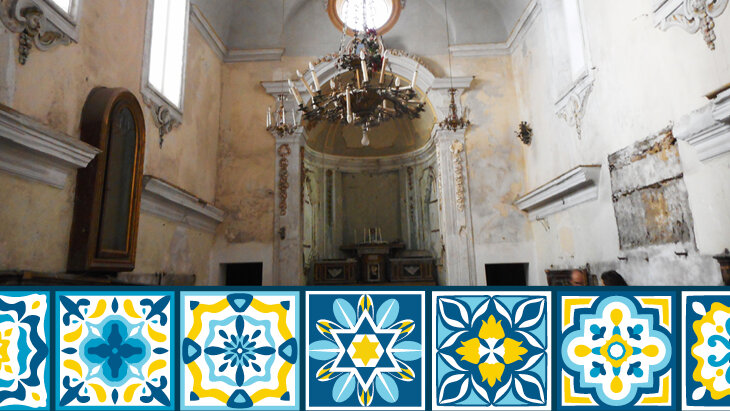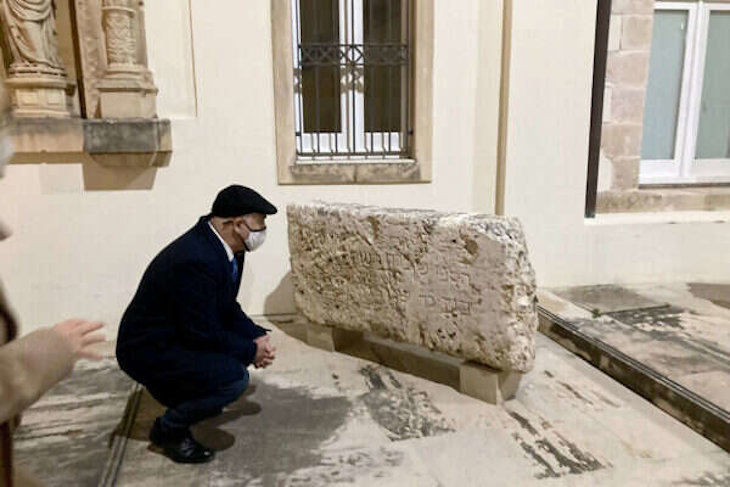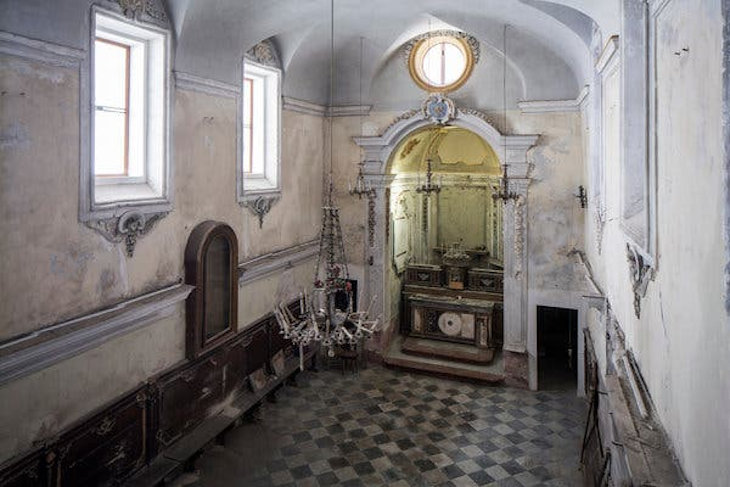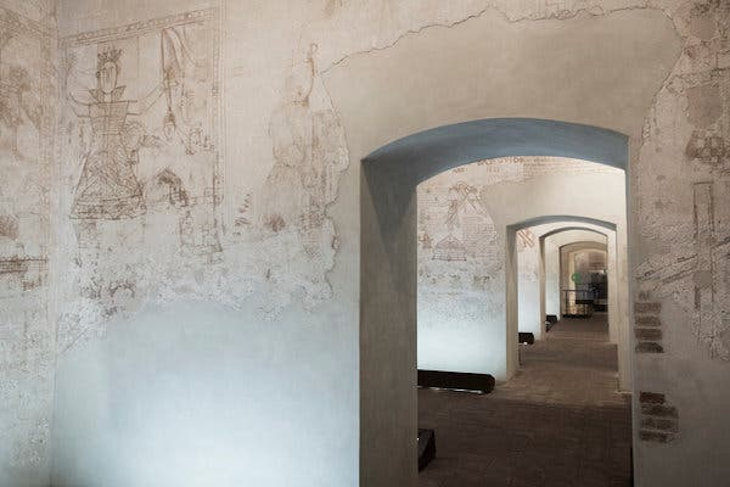 Passover’s Message of Hope in the Aftermath of Oct. 7
Passover’s Message of Hope in the Aftermath of Oct. 7

Jewish Geography

Jewish Geography
12 min read
A travel diary by Israel's ambassador to Italy.
Sicily has been the object of desire of many conquerors throughout history. A strategic location between three continents, it has attracted many kingdoms. Greece and Rome fought Carthage for control here and won. The Muslims were also here in the 10th and 11th centuries. The Normans (Vikings) and after them the Holy Roman Empire, France, Spain, and others. Before the unification of Italy in 1861, Sicily was under the control of the House of Bourbon in Napoli as part of the Kingdom of the Two Sicilies. The Jews were here, as well; some 30,000 before they were expelled from the island in January 1494 as part of the expulsion of the Jews of Spain (Sicily was then under the control of the Spanish crown).
For more than two years, we've been trying to come to Sicily, but the pandemic ruined our plans. Now we are here. We spent most of our time in the two main towns, Catania and Palermo. One afternoon we went to Syracuse, an ancient town on the east of the island, founded in the eighth century BCE by immigrants from Greece. One of its famous residents was Archimedes, the greatest mathematician of antiquity, whose inventions helped defend his town from the attacks of the Roman Republic in the third century BCE. In the end, however, the Romans triumphed.
 Looking at the remains of ancient Jewish headstones
Looking at the remains of ancient Jewish headstones
The Jews followed. For more than 1,500 years, Jews lived in the town (the second largest community on the island after Palermo, the capital) until they were expelled on the orders of Ferdinand and Isabella along with the rest of the Jews of Sicily. A historic irony is that in 1455, some 40 years before the deportation, the Jews asked to leave for the Land of Israel, but the authorities were opposed. The Jews were considered Servi camerae regis (servants of the royal chamber). They were arrested and the authorities planned to confiscate their property and sell them as slaves.
The affair ended with the payment of a huge ransom of 1,000 ounces of gold. There are similar stories about Jewish communities elsewhere, in other times. Jews tried to make aliyah to the Land of Israel even though it had been destroyed, and for thousands of years swore not to forget Jerusalem and dreamed about making the promises of a return to Zion come true.
After the expulsion of the Jews, the Syracuse cemetery was abandoned. In the following century, fortifications were constructed in the area of the small port and the sea flooded the tombs. It was only in the 1960s that they were found at the bottom of the port. Time and water had eroded the markings and little remained legible. We saw some of the tombs at the Bellomo Museum. I tried to decipher the ancient Hebrew carved on the stones and recall something of the Jewish names that lived here once and pay them respect; it has been many years since their names were read out loud after they sank into the depths. Rest in peace; your wishes have been granted.
We walked up the Road of the Jews, which has retained its Italian name, Via Della Giudecca (the ghetto had yet to be invented and the Jews crowded together for social reasons) and we reached a hotel where there was a very moving find: beautiful Jewish ritual baths (mikveh) from the ninth century!
The ritual baths were discovered by chance when the owner of the hotel, Amalia Daniele, wanted to restore it and discovered a vault that has been sealed off and filled up with dirt. It took more than 150 trucks to remove all the earth until at the bottom of a staircase five ritual baths that received their waters from the spring below were discovered. I was very moved since ritual baths mean Jewish life: families and love and children that were born and life that went on there for hundreds of years until being cut short by the expulsion.
 The ancient mikveh discovered underneath a Sicilian hotel
The ancient mikveh discovered underneath a Sicilian hotel
In the morning, we went to the historical archives in Palermo, where there are documents from the 13th century. A glass cabinet in the heart of the hall presents the protocols of the Sicilian Senate from 1492 with the decree to deport the Jews of the island, translated from Spanish to Sicilian:
"… We are informed by the Inquisitors … that great injury has resulted and still results… to steal faithful Christians from our holy Catholic faith and to separate them from it, and to draw them to themselves and subvert them to their own wicked belief and conviction … persuading them as much as they can to hold and observe the law of Moses, convincing them that there is no other law or truth except for that one.
"Therefore, we, with the counsel and advice of prelates, great noblemen of our kingdoms …resolve to order the said Jews and Jewesses of our kingdoms to depart and never to return or come back to them or to any of them…they depart from all of these our said realms and lordships… they shall not dare to return to those places… under pain that if they do not perform and comply with this command …they incur the penalty of death and the confiscation of all their possessions by our Chamber of Finance,
"Given in our city of Granada, the XXXI day of the month of March, the year of the birth of our Lord Jesus Christ, one thousand four hundred and ninety-two years. I, the King, I the Queen."
The Jews managed to postpone the decree until January-February 1493, because of the difficulty in expelling them and the severe harm that their departure would cause the economy and society. But in the end, they left (with the exception of those who converted to Christianity as a result of the edict and were then persecuted by the Spanish Inquisition's Sicilian branch). Fifteen centuries of Jewish presence in Sicily came to an end.
I stood in front of the book, open to the edict of expulsion, and thoughts about the fate of our people spun through my mind. The events of recent weeks in Ukraine also resonated. How fragile our lives are. The Jews were here for more than 1,000 years and are gone.
Where did they go? Some of them hoped to find rest nearby in Calabria or the Kingdom of Napoli, but they were expelled from there, as well, after not too long. Most of the exiles went to the Ottoman Empire, the Balkans, Greece, and Turkey. Many were robbed on the way, some were sold into slavery. The Way of the Jews in Syracuse looks out over the sea, to the east. Some of the exiles made it to Thessaloniki. Had they continued a little further east, they would have made it to the Land of Israel. After 400 years they were expelled from Thessaloniki, this time to Auschwitz. What do we know about the fate that awaits us awaits us?
 The former Baroque oratory known as Santa Maria del Sabato, or Holy Mary of Saturday, in the ancient Jewish quarter of Palermo, Sicily. It will soon become Palermo’s first synagogue in 500 years. Credit: Gianni Cipriano.
The former Baroque oratory known as Santa Maria del Sabato, or Holy Mary of Saturday, in the ancient Jewish quarter of Palermo, Sicily. It will soon become Palermo’s first synagogue in 500 years. Credit: Gianni Cipriano.
We left the archives and headed toward what was once the Jewish Quarter. Before the expulsion, the Great Synagogue was sold and became a church. In my meetings, I spoke with the president of Sicily and the mayor of Palermo about the importance of building at least one synagogue on the island to restore past glory. The church has contributed a building for this – a chapel (oratorio) with a fascinating name, "Maria del Sabato." The assumption is that this was a synagogue of conversos (crypto Jews) that operated despite the watchful eye of the Inquisition, whose torture chambers I had visited two days earlier.
 Palazzo Chiaramonte-Steri, today part of the University of Palermo, served as the prison and tribunal of the Inquisition. Its walls bear the writing of past inmates, including some in Hebrew. Credit: Gianni Cipriano
Palazzo Chiaramonte-Steri, today part of the University of Palermo, served as the prison and tribunal of the Inquisition. Its walls bear the writing of past inmates, including some in Hebrew. Credit: Gianni Cipriano
On one of the walls, one of the tortured Jews wrote the name of Jerusalem as his destination of desire, while others carved out letters of the Hebrew alphabet, a remnant of what they still knew of the holy tongue. I imagined them arriving secretly on eve of Shabbat, murmuring prayers or psalms, reminiscences of what had been passed on to them from previous generations, who had also forgotten their Jewish origin. The construction of a synagogue here will close another historical circle.
From the archives in Palermo, I returned directly to a Kabbalat Shabbat service in Rome. When we sang Lekha Dodi, I could see in my mind's eye the author of the prayer, Rabbi Shlomo Alkabetz. His parents were deported from Spain and he was born in Thessaloniki. He would have known the Sicilian exiles. He would not remain there long, and made aliyah to the Land of Israel. In Safed, he wrote the famous prayer in which he wished to awaken the people to shake off their shackles and renew themselves in their land. But wait a moment, the circle has yet to close.
At the beginning of that week, we met Italy's Minister of Culture, Dario Franceschini. Our eyes wandered to the palace, the Palazzo del Collegio Romano. The Ministry of Culture is located in its West Wing. The Collegio Romano was built in the 16th century and served as a Jesuit institution until Rome was captured in 1870 and became part of the young nation of Italy. It was here that Galileo Galilei revealed his discoveries and later disputed with the wise men of the Jesuit order about the validity of his scientific discoveries. For over 100 years, the Collegio Romano was home to the Italian National Library, and there are still antique collections with the intoxicating smell of old books.
In the meeting convention hall with its heavy wooden furniture, our eyes happened on a government bulletin with the number 1938. Interesting, we thought, perhaps we would find here the first publication of the "racial laws" enacted by the fascist government, in the wake of which the Jews of Italy were removed from society. We turned the pages expectantly and indeed, we found them in the chapter, "Decrees and Laws."
 Antisemitic race laws are recorded in black and white
Antisemitic race laws are recorded in black and white
"Royal Law Decree of November 17, 1938, XVII (the Latin numbers represent the figure 17 – the number of years since the fascists came to power), Nr. 1728. Provisions for the Defense of the Italian Race. Vitorio Emmanuel III with the grace of God and the will of the nation. King of Italy and Caesar of Ethiopia… I have heard the Committee of Ministers (the government); as per the proposal of Il Duce (Benito Mussolini) … (and other ministers); we decree: 1: Decrees concerning marriage … (prohibition of marriage between the Aryan race and other races)… 2: Membership of the Jewish race (definition of who is a Jew)… we declare that this decree bearing the seal of the state shall become part of the laws and decrees of the Kingdom of Italy…"
Three months earlier, on July 14, 1938, under the title "Fascism and the Racial Problem" Il Giornale d'Italia published a racial manifest stating that there is a "pure Italian race", and that: "The majority of the Italian population is of Aryan origin and its civilization is Aryan." The manifest was signed by a group of leading scientists and became the ideological and pseudo-scientific foundation for the racial laws that would later be adopted. It is a document we should be familiar with.
Its eighth clause states: "The Jews are not a part of the Italian race. Of the Children of Shem who resided for hundreds of years in our holy motherland, little is left. Even the Arab conquest in Sicily left little besides memories of a few names; after all, the process of assimilation was always a rapid one in Italy. The Jews (on the other hand) represent the one population that never assimilated in Italy because they have non-European racial components that are completely different to that from which the Italians were born."
And now Sicily is mentioned in a modern context of the racial laws, and the comparison between the documents that discuss the expulsion and exclusion of the Jews – almost 450 years apart – is shocking.
Today, Italy is doing a great deal to promote Holocaust commemoration. The school system, the media, and cultural institutions are all involved. I had the privilege of giving the award of Righteous Among the Nations to Italian families who risked their lives to save Jews. The Holocaust did not suddenly happen. It was the climax of 19 centuries of persecution that were enabled because the Jewish people did not have a national home. Thus the Holocaust was not sealed in 1945, but had a corrective epilogue. (Not corrective of the evil, but corrective of the conditions that enabled it). That epilogue was the establishment of the State of Israel.
In my meetings with the president of Sicily, he commented on the Sicilian language. He told me that it has no future tense and that the future is related in the present. He understands this as a testimony to realism and the desire not to fall prey to illusions. I told him that Hebrew, on the other hand, there is only one past tense: "In the beginning, God created the heavens and the earth" and, for example, "He created the vase just a moment ago."
Perhaps this is because for us, the past is not in a museum, but something we live with here and now. If we connect the Hebrew past to the Sicilian present, we might be able to create a better future.
This article originally appeared in Israel Hayom.

how moving this was to read, and helped me to understand why I have been so uncomfortable Ive felt coming to this area. in addition there is a church formally a synagogue in Castelmola where there are still clearly visible Star of David in the glass and stone work.